Looking for a new 4K TV? Are you overwhelmed by the vast selection of TVs on the market? We are here to help. In this article, we narrowed down the selection to two Samsung 4K TV models, TU7000 vs AU8000. So, let’s find out more about them.
Samsung TU7000 vs samsung AU8000 quick overview
Samsung offers a wide range of TV models, from entry-level to high-end models. TU7000 and AU8000 are both entry-level TVs, which means they provide good value for the cost.
These two models both support high 4K resolution, have a decent refresh rate and response time, and have a great contrast ratio since they have VA (Vertical Alignment) panels. So, let’s dive into a more detailed comparison of these two models. But first, let’s see how these two models compare when it comes to their basic features.
| Features | TU7000 | AU8000 |
|---|---|---|
| Screen Sizes (inches) | 43, 50, 55, 58, 60, 65, 70, 75, 82, and 85 inches | 43, 50, 55, 60, 65, 70, 75, and 85 inches |
| Screen Panel | VA | VA |
| Processor | Crystal Processor 4K | Crystal Processor 4K |
| Operating System | Tizen 2020 | Tizen 2021 |
| Refresh Rate | 60 Hz | 60 Hz |
| Variable Refresh Rate | No | No |
| Resolution | 4K | 4K |
| Contrast Ratio | 5,110:1 | 3,811:1 |
| HDMI Ports | 2x HDMI 2.0 | 3x HDMI 2.0 |
| USB Ports | 1 | 2 |
| Wi-Fi and Bluetooth | Yes | Yes |
| Speakers | 20 Watts (2.0 Channels) | 20 Watts (2.0 Channels) |
| Price | Check Price on Amazon | Check Price on Amazon |
Samsung TU7000
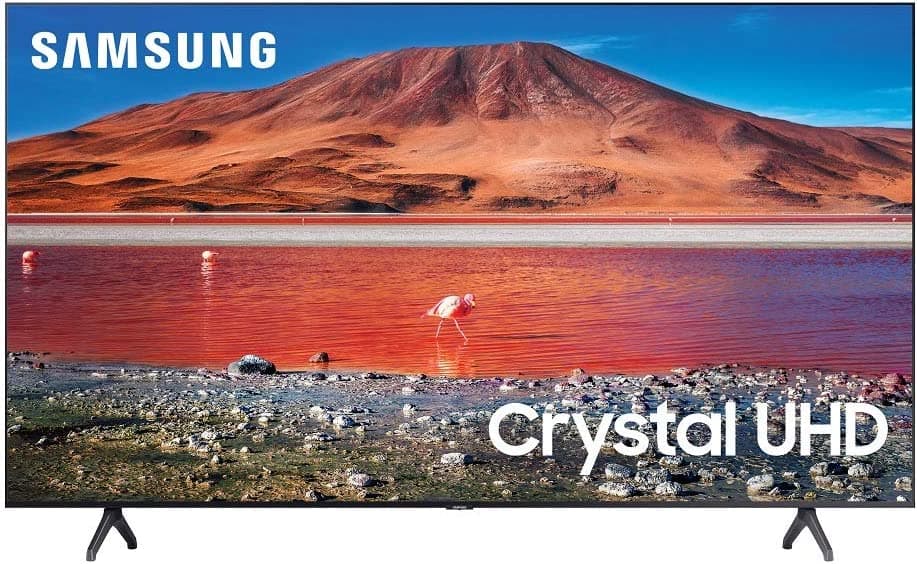
Pros:
- Fantastic contrast ratio
- Great image processor
- Plenty of screen size options
- Supports 1440p at 60Hz
Cons:
- No Bixby support
- Sub-par peak brightness
Samsung AU8000
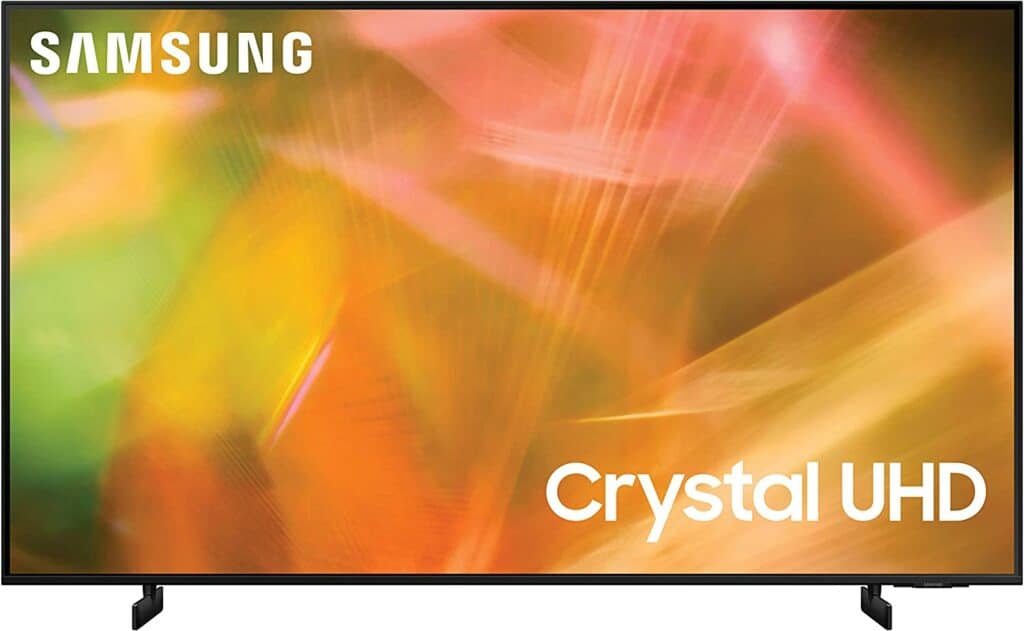
Pros:
- Plenty of HDMI and USB ports
- Smooth operating system
- Good reflection handling
- Bixby assistant
Cons:
- No 1440p at 60Hz support
- Lower contrast ratio comparatively
Features head to head
Panel technology
TU7000 and AU8000 both come with LED VA panels. VA or Vertical Alignment panels offer great picture quality if you watch it front and center.
However, if you move to either side, the picture quality drops. It means that VA panels have narrow viewing angles. However, VA panels have fantastic contrast and black uniformity.
Make sure to learn all about different types of panels before you opt for a TV.
Winner: Draw
Image processor
Each model in this comparison comes with the Crystal Processor 4K. This processor brings great picture quality at high resolution.
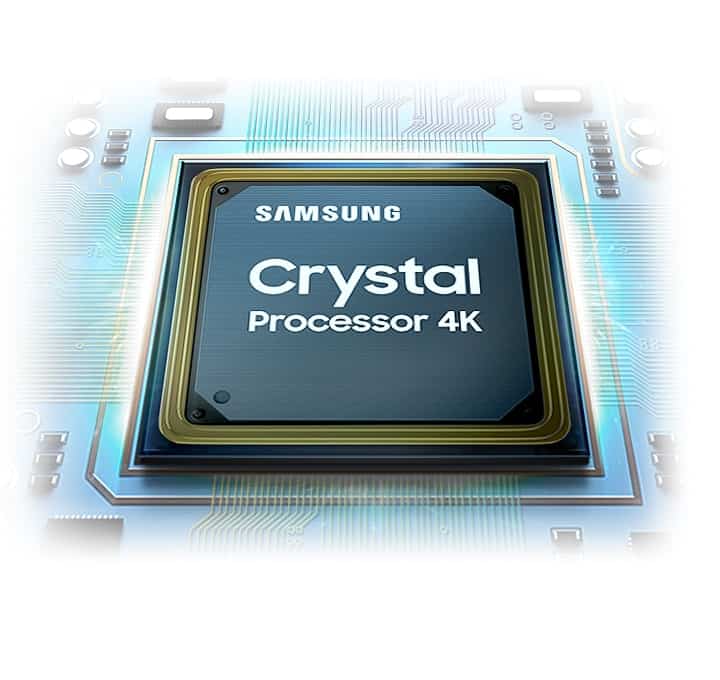
The processor has a 4K-upscaling feature which means you get near 4K resolution for any content you play.
Winner: Draw
Motion Technology
Unfortunately, these two TV models only offer a 60Hz refresh rate and have no variable refresh rate support. However, that doesn’t mean they are a bad choice for gaming since they have decent response time and input lag.
| Performance features | TU7000 | AU8000 |
|---|---|---|
| Refresh rate | 60 Hz | 60 Hz |
| Variable refresh rate | No | No |
| Response time | 6.3 ms | 6.9 ms |
| Input lag 4K at 60 Hz | 10.3 ms | 11.1 ms |
| Input lag 1080P at 60 Hz | 10.2 ms | 10.9 ms |
TU7000 comes with Auto Game Mode (ALLM), which minimizes input lag and optimizes the screen for gaming purposes. So, overall, it minimizes judder and motion blur.
AU8000 comes with a Motion Xcelerator feature which also minimizes motion blur. It is a useful feature for fast-moving scenes, whether you’re gaming or watching sports.
Winner: Draw
Picture Quality
One of the main indicators of the picture’s quality is its resolution. Most TVs today come with 4K or 8K resolution. Even though they support higher resolutions, these TVs also support lower resolutions, such as 1080p.
But when looking at the picture quality, you also need to check the resolution in relation to the refresh rate. As we can see in the table below, both TU7000 and AU8000 support up to 4K resolution at 60 Hz.
| Resolution | TU7000 | AU8000 |
|---|---|---|
| 8K | No | No |
| 4K/144Hz | No | No |
| 4K/120Hz/4:4:4 | No | No |
| 4K/120Hz | No | No |
| 4K/60Hz/4:4:4 | Yes | Yes |
| 4K/60Hz | Yes | Yes |
| 1440p/144Hz | No | No |
| 1440p/120Hz | No | No |
| 1440p/60Hz | Yes (forced resolution required) | No |
| 1080p/144Hz | No | No |
| 1080p/120Hz | No | No |
| 1080p/60Hz/4:4:4 | Yes | Yes |
| Price | Check Price on Amazon | Check Price on Amazon |
Neither of them supports 8K resolution. But these two TV models also differ regarding 1440p resolution — TU7000 supports 1440p at 60Hz, while AU8000 doesn’t.
Contrast Ratio / Black Level
The contrast ratio tells you the brightness difference between black and white. A higher contrast ratio means better picture quality. This difference is best visible when you watch dark scenes.
Samsung TU7000 has a contrast ratio of 5,110:1, whereas AU8000 has a contrast ratio of 3,811:1. They both have a great contrast ratio, but TU7000 has the better performance.
Winner: TU7000
Local Dimming
These TV models don’t support the “local dimming” feature. So, you can’t improve the contrast ratio. The good thing is that both of these TVs have a good contrast ratio. This means you can enjoy deep blacks while watching dark scenes on the TV in a dark room.
Winner: Draw
Peak Brightness
We can’t really say that either of these two TV models excels when it comes to brightness. They have a decent brightness level. Samsung TU7000 can reach 264 Nits, whereas the AU8000 model stands a little better and can reach a maximum of 330 Nits.
As a result, they can’t boast their performance when it comes to SDR and HDR brightness. TU7000 has below-average SDR brightness. AU8000 has a slightly better SDR brightness, but again, nothing to brag about.
The situation is worse when it comes to HDR peak brightness. Neither of them is bright enough to properly show the HDR content.
You can try to play around with different features such as Contrast Enhancer or increase the overall contrast or brightness. This can help with the dark scenes, so they could become slightly brighter. Before you opt for a TV, make sure to learn a little bit more about SDR and HDR.
Since it has better overall peak brightness and performs better when it comes to SDR and HDR brightness, AU8000 wins in this segment.
Winner: AU8000
Color
Neither of these two TVs has a wide color gamut. Color gamut shows us how many colors a TV can reproduce. Unfortunately, TU7000 doesn’t have a wide color gamut, so the colors are limited.
AU8000 does a little better in this segment. It has a good color gamut. It is not perfect, but it is better than the TU7000 model.
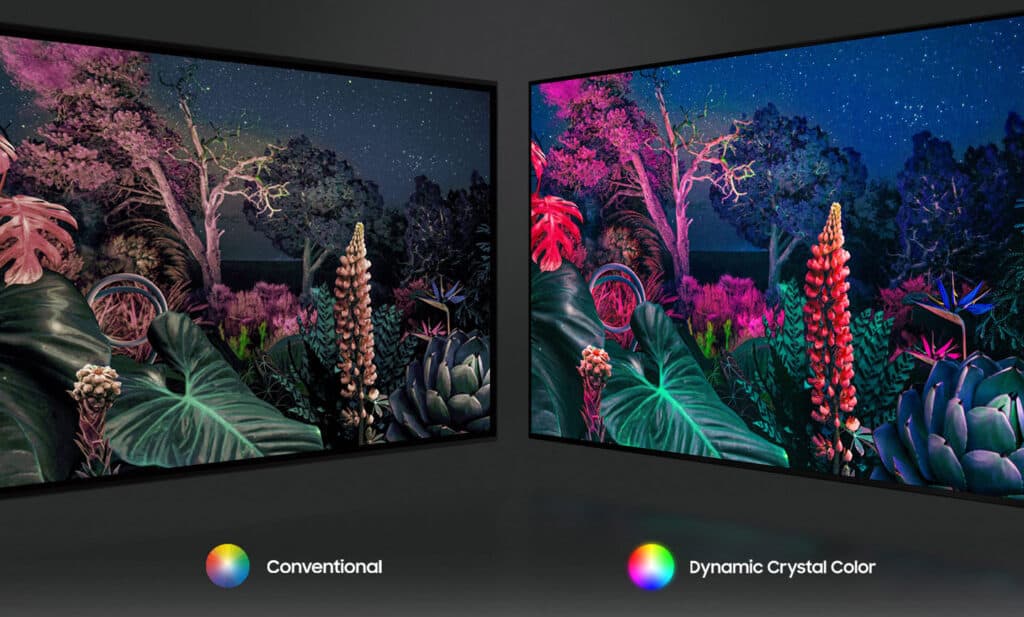
Color volume is also an important aspect of picture quality. TU7000 has a decent color volume. Since it has a good contrast ratio, it displays darker colors well but struggles with blue colors and brighter colors. The same goes for the AU8000. It also does well with dark colors but not so well with brighter colors.
However, these two TVs have great gradient handling. On TU7000, you could face a little banding in dark gray and green. On AU8000, there is some banding in green and red colors.
The AU8000 model prevails in this segment because it has a wider color gamut than the TU7000 model.
Winner: AU8000
Viewing Angle
You should pay attention to viewing angles if you have a wide sitting area. When you watch TVs with poor viewing angles, you can experience things like color shifts, lost brightness, raised black levels, etc.
In general, the best viewing angle is right in front of the TV. As you move to each side, the viewing angle worsens.
Some TVs have good viewing angles, so you only see shifts at extreme angles. But this is not the case with VA panels since they are known for poor viewing angles.
Unfortunately, both models in our Samsung AU8000 vs TU7000 comparison have poor viewing angles. Narrow viewing angles are a result of both TVs having the VA panel. If you have a wide seating area, consider getting an IPS panel.
Winner: Draw
Reflections / Anti-Glare
This is one of the segments in which TV models in our TU7000 vs AU8000 comparison differ the most. AU8000 excels in this category since it handles reflections very well.
TU7000, on the other hand, does an okay job. However, it is recommended not to place it opposite a light source or in direct sunlight.
Both models have a semi-gloss finish. They differ significantly when it comes to reflections in total. AU8000 has a little bit over 3% of total reflections, whereas TU7000 has almost double the number of reflections.
Winner: AU8000
Sound Quality
The sound quality is not that great when it comes to either TV. They both have 2 channels and 20-Watt speakers. It is good enough for casual TV watching, sports, broadcasts, etc.
But if you expect powerful audio and a cinematic surround experience, you will be disappointed. This is, unfortunately, pretty much expected from entry-level TVs. For example, TU8000 also has the same sound quality.
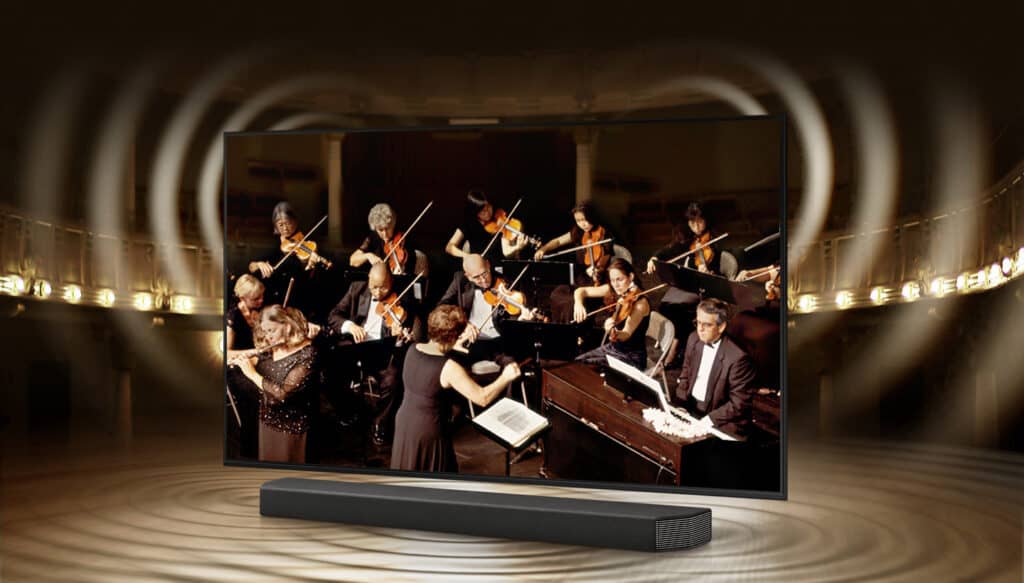
For that reason, we recommend that you get a soundbar if you want a great audio experience. Be aware that there are different types of soundbars. Above all, you should know the difference between the 2.1 and 5.1 soundbars.
Since these two TVs offer practically the same audio experience, it is a draw in this segment.
Winner: Draw
Smart TV Platform (Operating System)
As both of these TV models are made by Samsung, they use the same operating system — Tizen. But TU7000 uses the 2020 version, which, even though easy to use, is not so smooth. But it works well and has no bugs.
| Interface | TU7000 | AU8000 |
|---|---|---|
| Smart OS | Tizen 2020 | Tizen 2021 |
| Ease of use | Easy | Easy |
| Smoothness | Average | Very smooth |
| Time taken to select YouTube | 2s | 2s |
| Time taken to change backlight | 7s | 5s |
AU8000 uses the newer 2021 version of Tizen. The main difference, when compared to the 2020 version, is that it has much smoother navigation.
Winner: AU8000
Connectivity
Inputs
AU8000 has more ports when it comes to both HDMI and USB connectivity. It has three HDMI and two USB ports. TU7000 has two HDMI ports and only one USB port.
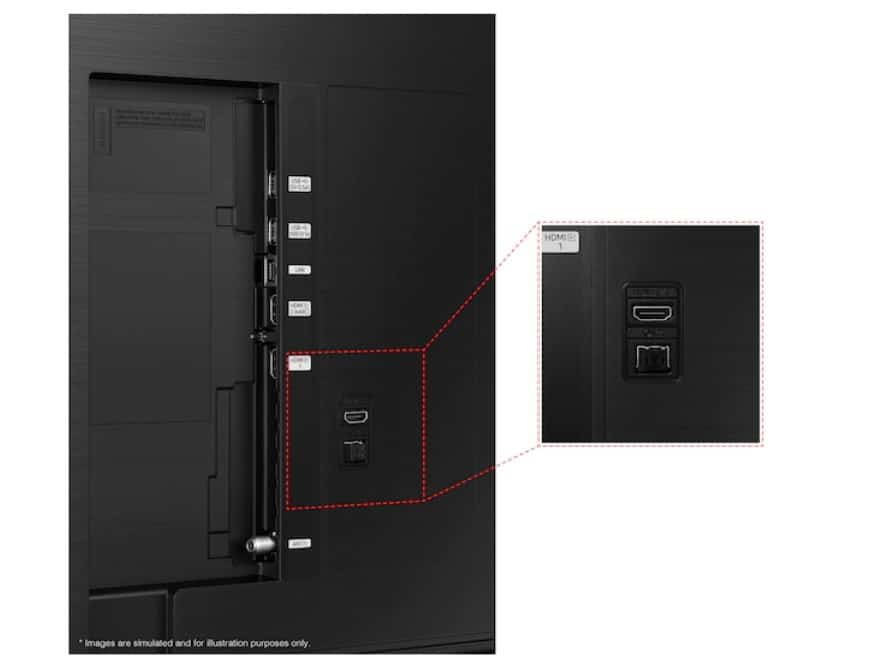
They are the same when it comes to the type of these ports. Both support HDMI 2.0 and USB 2.0.
| Input type | TU7000 | AU8000 |
|---|---|---|
| HDMI | 2 | 3 |
| USB | 1 | 2 |
| Digital Optical Audio Out | 1 | 1 |
| Analog Audio Out 3.5mm | 0 | 0 |
| Ethernet | 1 | 1 |
They also both support ethernet and digital optical audio out. However, both lack analog audio out (3.5 mm). Since AU8000 has more ports overall, it takes a win in this segment.
Winner: AU8000
Voice Assistants
Each of these two TV models works with Amazon Alexa and Google Assistant. But they differ when it comes to Bixby support. AU8000 comes with Bixby, whereas TU7000 doesn’t. Both models have a great selection of apps.
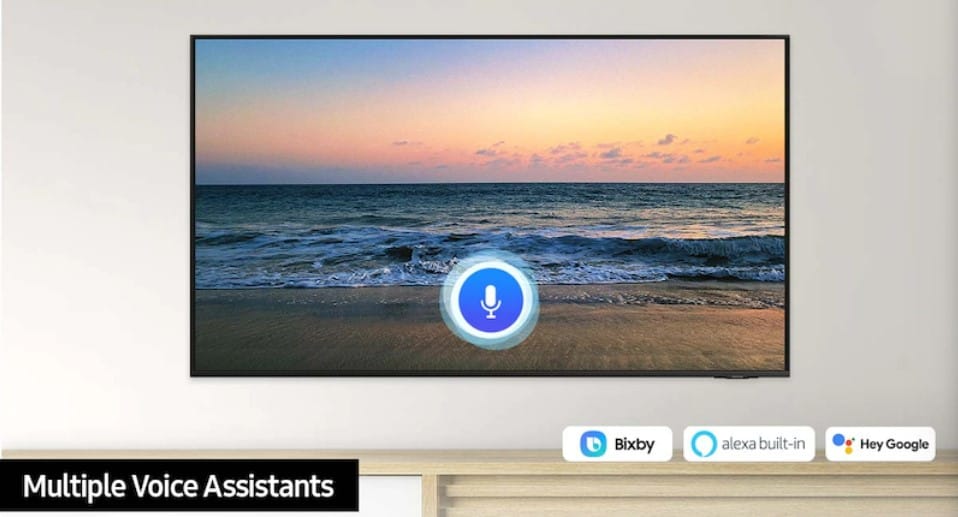
It is important to mention that even though they are both entry-level models, they have different remotes. First of all, they differ in size, since AU8000 comes with a much smaller remote.
But the biggest difference is the presence of voice control. TU7000’s remote has no voice control, whereas AU8000’s remote includes this feature.
Winner: AU8000
Wireless Technologies
The good news is that both of these TV models support Wi-Fi connectivity. TU7000 and AU8000 support WiFi5. Both TV models also support Bluetooth connectivity, version 4.2.
Winner: Draw
Conclusion
So, which TV is better, Samsung TU7000 vs AU8000? It depends on the features you want to have in your TV model.
TU7000 has a fantastic contrast ratio, so you can enjoy deep blacks, especially when you watch your TV in a dark room. It also supports various resolutions, all the way up to 4K resolution. You can also choose from numerous screen sizes.
AU8000 comes with lots of HDMI and USB ports, and alongside WiFi and Bluetooth, you won’t have connectivity issues. It is also great at handling reflections, so you can watch the TV in dark and bright rooms. This TV model comes with the Bixby assistant and an upgraded Tizen TV platform.